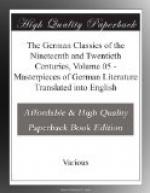Thus is the proposition further determined, but, at the same time, this asserted, that, in Nature, the perfect is mingled with the imperfect, the beautiful with the unbeautiful. Now, how should he who stands in no other relation to Nature than that of servile imitation, distinguish the one from the other? It is the way of imitators to appropriate the faults of their model sooner and easier than its excellences, since the former offer handles and tokens more easily grasped; and thus we see that imitators of Nature in this sense have imitated oftener, and even more affectionately, the ugly than the beautiful.
If we regard in things, not their principle, but the empty abstract form, neither will they say anything to our soul; our own heart, our own spirit we must put to it, that they answer us.
But what is the perfection of a thing? Nothing else than the creative life in it, its power to exist. Never, therefore, will he, who fancies that Nature is altogether dead, be successful in that profound process (analogous to the chemical) whence proceeds, purified as by fire, the pure gold of Beauty and Truth.
Nor was there any change in the main view of the relation of Art to Nature, even when the unsatisfactoriness of the principle began to be more generally felt; no change, even by the new views and new knowledge so nobly established by John Winckelmann. He indeed restored to the soul its full efficiency in Art, and raised it from its unworthy dependence into the realm of spiritual freedom. Powerfully moved by the beauty of form in the works of antiquity, he taught that the production of ideal Nature, of Nature elevated above the Actual, together with the expression of spiritual conceptions, is the highest aim of Art.
But if we examine in what sense this surpassing of the Actual by Art has been understood by the most, it turns out that, with this view also, the notion of Nature as mere product, of things as a lifeless result, still continued; and the idea of a living creative Nature was in no wise awakened by it. Thus these ideal forms also could be animated by no positive insight into their nature; and if the forms of the Actual were dead for the dead beholder, these were not less so. Were no independent production of the Actual possible, neither would there be of the Ideal. The object of the imitation was changed; the imitation remained. In the place of Nature were substituted the sublime works of Antiquity, whose outward forms the pupils busied themselves in imitating, but without the spirit that fills them. These forms, however, are as unapproachable, nay, more so, than the works of Nature, and leave us yet colder if we bring not to them the spiritual eye to penetrate through the veil and feel the stirring energy within.
On the other hand, artists, since that time, have indeed received a certain ideal impetus, and notions of a beauty superior to matter; but these notions were like fair words, to which the deeds do not correspond. While the previous method in Art produced bodies without soul, this view taught only the secret of the soul, but not that of the body. The theory had, as usual, passed with one hasty stride to the opposite extreme; but the vital mean it had not yet found.




